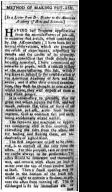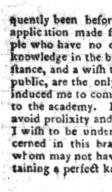[ Method of Making Pot-Ash ] Dr. Dexter
Date: 1789/12/01
Source:
Nova Scotia Magazine
Institution: Nova Scotia Archives
| Source Origin: Nova Scotia Newspapers on Microfilm
| Reference: Microfilm Reels 8062, 8063
Instructions on how to make postash that had been presented to the American Society of Arts and Sciences. nn.442_44. Microfilm Reel 8062.
METHOD OF MAKING POT-ASH.
[In a Letter from Dr. Dexter to the American
Academy of Arts and Sciences.]
HAVING had frequent applications
from the manufacturers of pot-ash,
to examine that article, when condemned
by the Assaymasters; I have been led to
several observations, which are generally
the result of experiments, respecting its
defects and the causes of its impurity.
From a conviction that those defects may
be easily remedied, I have committed my
remarks to paper, with a concise history
of the manufacturing this salt, which I
beg leave to submit to the consideration of,
the American Academy of Arts and Sci-
ences; and if after their critical examina-
tion, they shall be thought to contain any
useful hints, they will dispose of them as
they think proper.
It is unnecessary to premise, that the
great evil which injures the sale, and very
much reduces the value of some of the
American pot-ash, arises from foreign
matters, such as common salt and earth,
being accidentally mixed with it.
The furnaces and machines or appara-
tus commonly used in this country, for
extracting the salts from the ashes, and
for boiling and fluxing them, are un-
doubtedly of good kind.
The first important object to be obser-
ved, is to extract all the salts from the
ashes. For this purpose, rain or river wa-
ter ought always to be preferred.--The
ashes should be saturated and thoroughly
wet, and remain with about an inch of
water over the top of them twelve hours
at least. Then a small opening may be
made in the bottom of the leach tub,
which ought to contain a strainer, to pre-
vent the ashes from running off. The lie
discharged is fit for immediate use. As
[page break]
soon as the manufacturer begins to draw
it off, he must apply fresh water, and con-
tinue that application and boiling the lies,
until they are so reduced in strength, as
that they will no longer pay the expence of
boiling. The ashes are, however, still to
be preserved, and fresh water applied as
before; and when drawn off they may be
used with profit on fresh ashes, as long as
there remain in the lies any salts, which
may be discovered by the taste.
The lie that runs off for use, should be
filtered as it passes the bottom of the tub
and also as it runs into the receiver;
which process may be performed without
any expence or inconvenience, through
clean straw. Previous to boiling the lie
it ought to stand twenty four hours, and
then be drawn into the kettles with great
care, so as to leave all the sediment be-
hind. Every precaution should be taken
to let nothing fall into the lies previous to,
and whilst boiling: Therefore that inju-
rious practice of laying wood on the ket-
tels for drying, must be avoided.
Strong lies may always be boiled half
away in the first operation, and others
much more. After which they must be
taken with care out of the kettles and put
into a receiver at hand. Being so shifted,
a very small quantity of unslackened lime
may be put into it, which serves to clari-
fy, and at the same time renders the lie
more pungent to the taste. After standing
quiet until it cools to the state of blood
heat, it must be again shifted; and in
drawing off the lie in every instance, the
utmost care must be taken that all the se-
diment, which is generally a chalky earth,
is detained, which process will effectually
separate all the common salt, for that will
congeal and crystallize with hot water in
the same quantity as with cold water,
which is not the cafe with any neutral
salt or alkali. If after all, from any cir-
cumstance unforeseen, the lies shall not
appear pure and clean, after taken from
the last sediment, they must stand quiet
until another is formed, or until it ap-
pears that no other will form; should one
form, it must be separated as before, pri-
or to its being put into the kettles for the
last operation. Without these precauti-
ons the pot-ash, in consequence of neutral
salts and a chalky matter which are ob-
tained from the ashes, will be hard to flux,
and require a long time to effect it; Which
will greatly endanger the kettles; and af-
ter it is fluxed will be very impure, and
sell for a reduced price, if the owner be
fortunate enough to find a market at any
rate.
The pot-ashes which I have examines,
that have been condemned by the Assay-
____
masters, I have found to contain princi
pally common earth, which is undoubted-
ly the chief source of impurity in the pot-
ash of this country. If any crystals of
common salt or nitre appear in the sedi-
ment, they may be preserved and purified
by an easy process, which is known to
people in general, who have attended to
the manufacturing of salt petre.
After the lie is properly cleared from
earthy matter and common salt, which not
only retards the fluxing process, as has
been observed, but renders it unfit for
many uses, particularly the bleaching of
linens, it must continue boiling until eva-
poration shall cease, then the fire must be
increased until the salts are perfectly flux-
ed, for the purpose of destroying the in-
flammable substance, with which most of
them abound which may be determined
by the following simple method. Take
some pot-ash and dissolve it in water: Let
there be as much pot-ash as the water
will dissolve. The plunge a piece of sil-
ver coin, or any thin plate of silver into
the solution. If the pot-ash contains any
inflammable matter, it will change the sil-
ver to a dark or black colour, in the same
manner as if it had been over the steam of
burning sulphur. By this easy experi-
ment the manufacturer will be saved the
expence and mortification of carrying
pot-ash to market, which must sell for a
very reduced price. Should the work-
men discover, on the experiment being
made, the inflammable principle, or what
is called by the workmen the oily sub-
stance, or fire, to exist in the pot-ash, it
can be remedied only by dissolving in pure
water, and boiling it down and fluxing it
a second time; or it may be made into
pearl ashes, by calcination, with little ex-
pence.
Some manufacturers may be discoura-
ged from going through this process, by
the labour necessary in shifting the lie so
often. But if they consider the advanta-
ges they will obtain in fluxing their pot-
ash, which will be effected in less than
half the time required in the usual way,
and the great saving in the expence of
kettles, by the lies being made clean and
pure; they will be reconciled to the me-
thod, notwithstanding their trouble, as
their interest will be found on the experi-
ment, to be concerned in its adoption, and
as their pot-ash will find a more speedy
market, and obtain a higher price. Be-
sides, the manufacturer and the merchant
will never be doubtful of their adven-
tures, and the reputation of American pot-
ash will be equal if not superior to any
that is manufactured in Europe.
The subject of pot-ash making, has fre-
[page break]
quently been before the legislature, and
application made for premiums, by peo-
ple who have no doubt acquired useful
knowledge in the business. This circum-
stance, and a wish to render service to the
public, are the only motives which have
induced me to commit these observations
to the academy. I have endeavoured to
avoid prolixity and all chymical terms, as
I wish to be understood by people con-
cerned in this branch of business, all of
whom may not have had the means of ob-
taining a perfect knowledge of them.
Download: Transcription | Images


